
The Baths of Diocletian were public baths in ancient Rome. Named after emperor Diocletian and built from AD 298 to 306, they were the largest of the imperial baths. The project was originally commissioned by Maximian upon his return to Rome in the autumn of 298 and was continued after his and Diocletian's abdication under Constantius, father of Constantine.
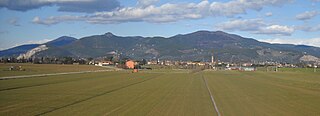
The province of Pisa is a province in the Tuscany region of central Italy. Its capital is the city of Pisa. With an area of 2,448 square kilometres (945 sq mi) and a total population of 421,642, it is the second most populous and fifth largest province of Tuscany. It is subdivided into 37 comuni.
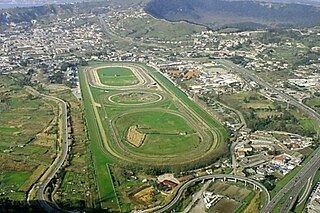
Agnano is a suburb of Napoli, Italy, situated southwest of the city in the Campi Flegrei region. It was popular among both ancient Greeks and Romans and was famed for its hot sulphurous springs.
Cyriacus, sometimes Anglicized as Cyriac, according to Christian tradition, is a Christian martyr who was killed in the Diocletianic Persecution. He is one of twenty-seven saints, most of them martyrs, who bear this name, of whom only seven are honoured by a specific mention of their names in the Roman Martyrology.
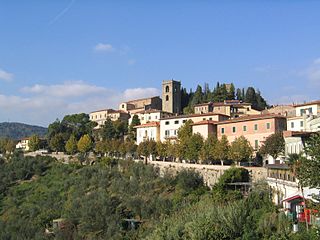
Montecatini Terme is an Italian municipality (comune) of c. 20,000 inhabitants in the province of Pistoia, Tuscany, central Italy. It is the most important center in Valdinievole. The town is located at the eastern end of Piana di Lucca and has a strong tourism industry, as well as industrial and commercial industries related to the spa, which in turn has increased the interest in hotel accommodation in the region.
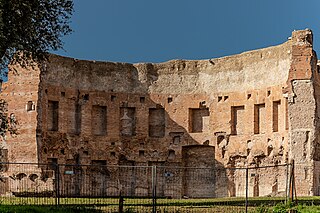
The Baths of Trajan were a massive thermae, a bathing and leisure complex, built in ancient Rome and dedicated under Trajan during the kalendae of July 109, shortly after the Aqua Traiana was dedicated.

Bagni di Lucca is a comune of Tuscany, Italy, in the Province of Lucca with a population of about 6,100. The comune has 27 named frazioni (wards).
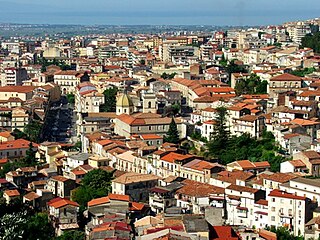
Lamezia Terme, commonly called Lamezia, is an Italian city and comune of 70,452 inhabitants (2013), in the province of Catanzaro in the Calabria region.

Cascina is a comune (municipality) in the Province of Pisa in the Italian region Tuscany, located about 60 kilometres (37 mi) west of Florence and about 13 kilometres (8 mi) southeast of Pisa.

Ponsacco is a comune (municipality) in the Province of Pisa in the Italian region Tuscany, located about 50 kilometres (31 mi) southwest of Florence and about 20 kilometres (12 mi) southeast of Pisa.

Chianciano Terme is a comune (municipality) in the Province of Siena in the Italian region Tuscany, located about 90 kilometres (56 mi) southeast of Florence and about 50 kilometres (31 mi) southeast of Siena. It is located between the Valdichiana and the Val d'Orcia.

San Casciano dei Bagni is a comune (municipality) in the Province of Siena in the Italian region of Tuscany, located about 110 km (68 mi) southeast of Florence and about 70 km (43 mi) southeast of Siena. It is a member of the I Borghi più belli d'Italia association.

Eusebio Giacinto Valli was an Italian physician and scientist.

The Suburban Baths are a building in Pompeii, Italy, a town in the Italian region of Campania that was buried by the eruption of Mount Vesuvius in 79 AD, which consequently preserved it.

Suio is a frazione of Castelforte, a municipality in southern Latium, central Italy.
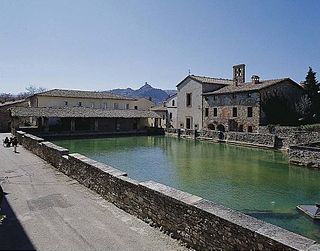
Bagno Vignoni is an Italian village and hamlet (frazione) of San Quirico d'Orcia, situated on a hill above the Val d'Orcia in Tuscany. It is a popular tourist destination and well known for its hot springs.
Casciana Terme Lari is a comune (municipality) in the Province of Pisa in the Italian region Tuscany, located about 60 kilometres (37 mi) southwest of Florence and about 30 kilometres (19 mi) southeast of Pisa.

The Segestan thermal baths are hydrothermal springs located in Sicily, between Alcamo and Castellammare del Golfo, in the province of Trapani.

San Ruffino is a village in Tuscany, central Italy, administratively a frazione of the comune of Casciana Terme Lari, province of Pisa. At the time of the 2001 census its population was 72.



















